Ending Homelessness: Analyzing Elderly Population in Canada
VerifiedAdded on 2023/05/30
|6
|1268
|159
Essay
AI Summary
This essay examines the growing issue of elderly homelessness in Canada, highlighting the diverse backgrounds of homeless individuals while noting the increasing number of elderly citizens seeking shelter. It identifies rising housing costs, poverty, social alienation, violence, and abuse as key factors contributing to this problem. The essay critiques ineffective governmental policies and insufficient subsidies, which exacerbate the difficulties faced by elderly individuals in covering monthly and medical expenses due to a lack of savings and superannuation plans. Consequently, homelessness leads to mental health issues, depression, addiction, and social alienation. The essay also assesses the effectiveness of programs like "Service for Seniors" and "Alberta Seniors" in providing shelter and affordable housing. It concludes by emphasizing the need for increased welfare rates and simpler procedures to support the elderly population financially, advocating for easier access to welfare programs to address the complex challenges of homelessness.
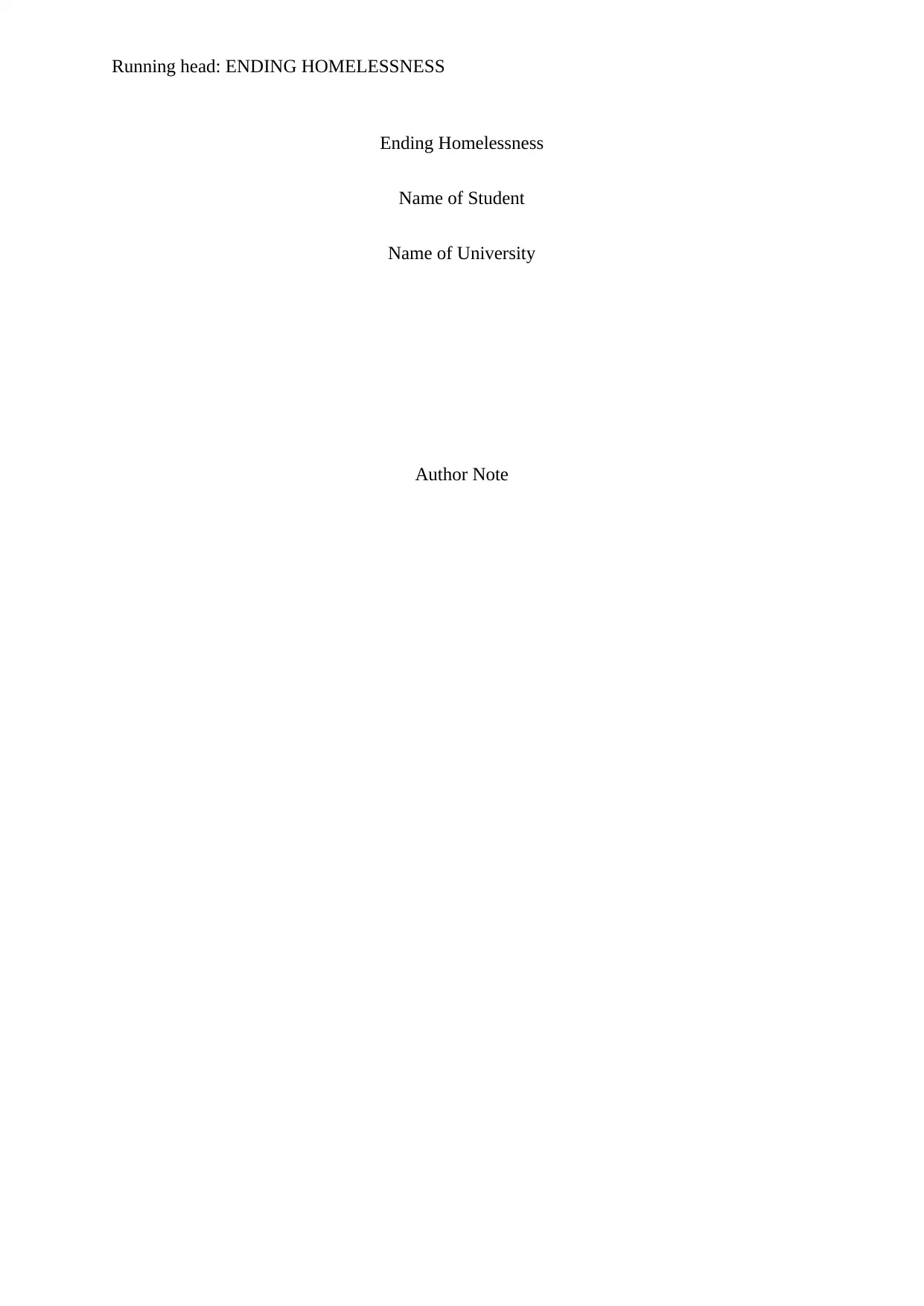
Running head: ENDING HOMELESSNESS
Ending Homelessness
Name of Student
Name of University
Author Note
Ending Homelessness
Name of Student
Name of University
Author Note
Paraphrase This Document
Need a fresh take? Get an instant paraphrase of this document with our AI Paraphraser
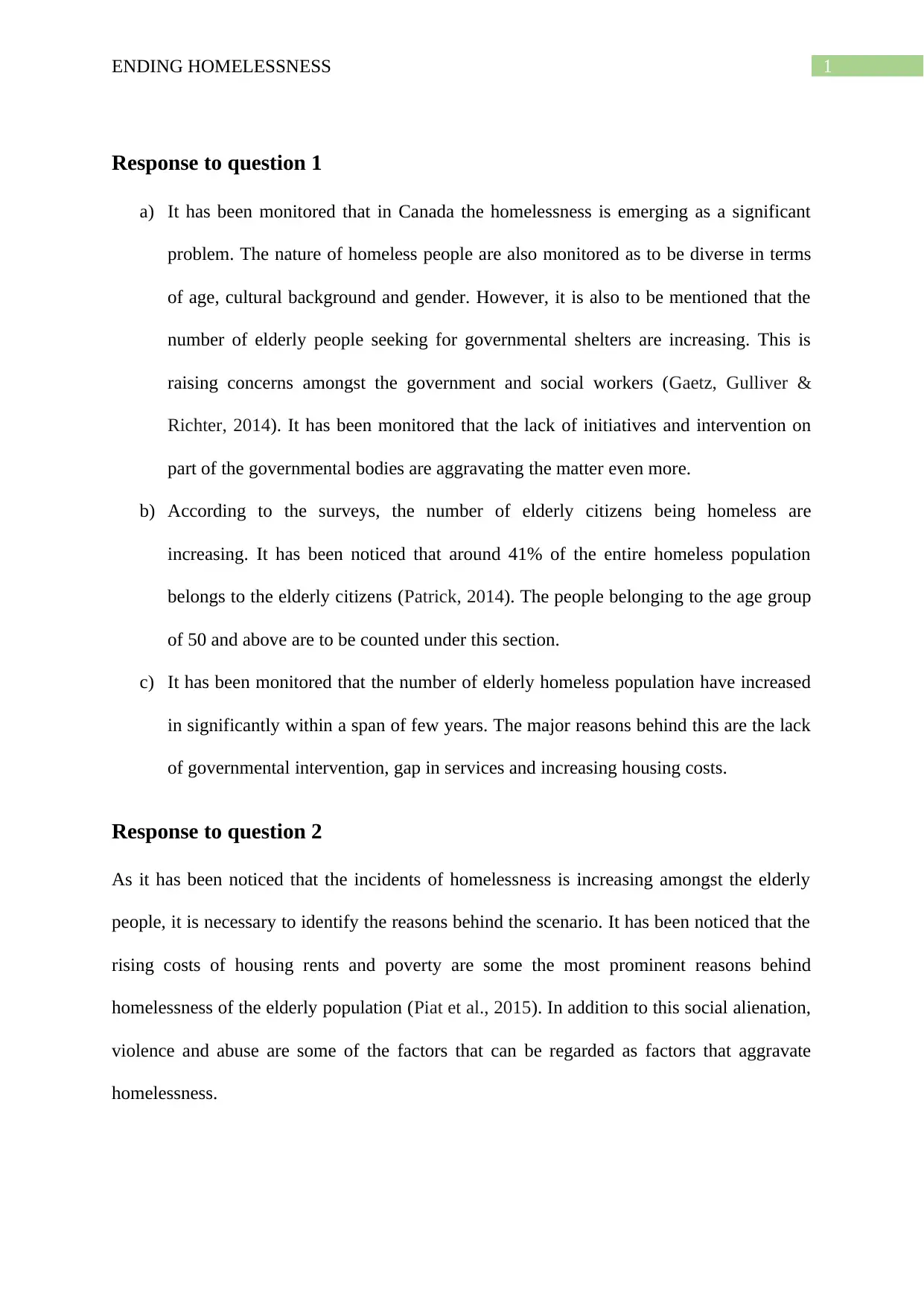
1ENDING HOMELESSNESS
Response to question 1
a) It has been monitored that in Canada the homelessness is emerging as a significant
problem. The nature of homeless people are also monitored as to be diverse in terms
of age, cultural background and gender. However, it is also to be mentioned that the
number of elderly people seeking for governmental shelters are increasing. This is
raising concerns amongst the government and social workers (Gaetz, Gulliver &
Richter, 2014). It has been monitored that the lack of initiatives and intervention on
part of the governmental bodies are aggravating the matter even more.
b) According to the surveys, the number of elderly citizens being homeless are
increasing. It has been noticed that around 41% of the entire homeless population
belongs to the elderly citizens (Patrick, 2014). The people belonging to the age group
of 50 and above are to be counted under this section.
c) It has been monitored that the number of elderly homeless population have increased
in significantly within a span of few years. The major reasons behind this are the lack
of governmental intervention, gap in services and increasing housing costs.
Response to question 2
As it has been noticed that the incidents of homelessness is increasing amongst the elderly
people, it is necessary to identify the reasons behind the scenario. It has been noticed that the
rising costs of housing rents and poverty are some the most prominent reasons behind
homelessness of the elderly population (Piat et al., 2015). In addition to this social alienation,
violence and abuse are some of the factors that can be regarded as factors that aggravate
homelessness.
Response to question 1
a) It has been monitored that in Canada the homelessness is emerging as a significant
problem. The nature of homeless people are also monitored as to be diverse in terms
of age, cultural background and gender. However, it is also to be mentioned that the
number of elderly people seeking for governmental shelters are increasing. This is
raising concerns amongst the government and social workers (Gaetz, Gulliver &
Richter, 2014). It has been monitored that the lack of initiatives and intervention on
part of the governmental bodies are aggravating the matter even more.
b) According to the surveys, the number of elderly citizens being homeless are
increasing. It has been noticed that around 41% of the entire homeless population
belongs to the elderly citizens (Patrick, 2014). The people belonging to the age group
of 50 and above are to be counted under this section.
c) It has been monitored that the number of elderly homeless population have increased
in significantly within a span of few years. The major reasons behind this are the lack
of governmental intervention, gap in services and increasing housing costs.
Response to question 2
As it has been noticed that the incidents of homelessness is increasing amongst the elderly
people, it is necessary to identify the reasons behind the scenario. It has been noticed that the
rising costs of housing rents and poverty are some the most prominent reasons behind
homelessness of the elderly population (Piat et al., 2015). In addition to this social alienation,
violence and abuse are some of the factors that can be regarded as factors that aggravate
homelessness.
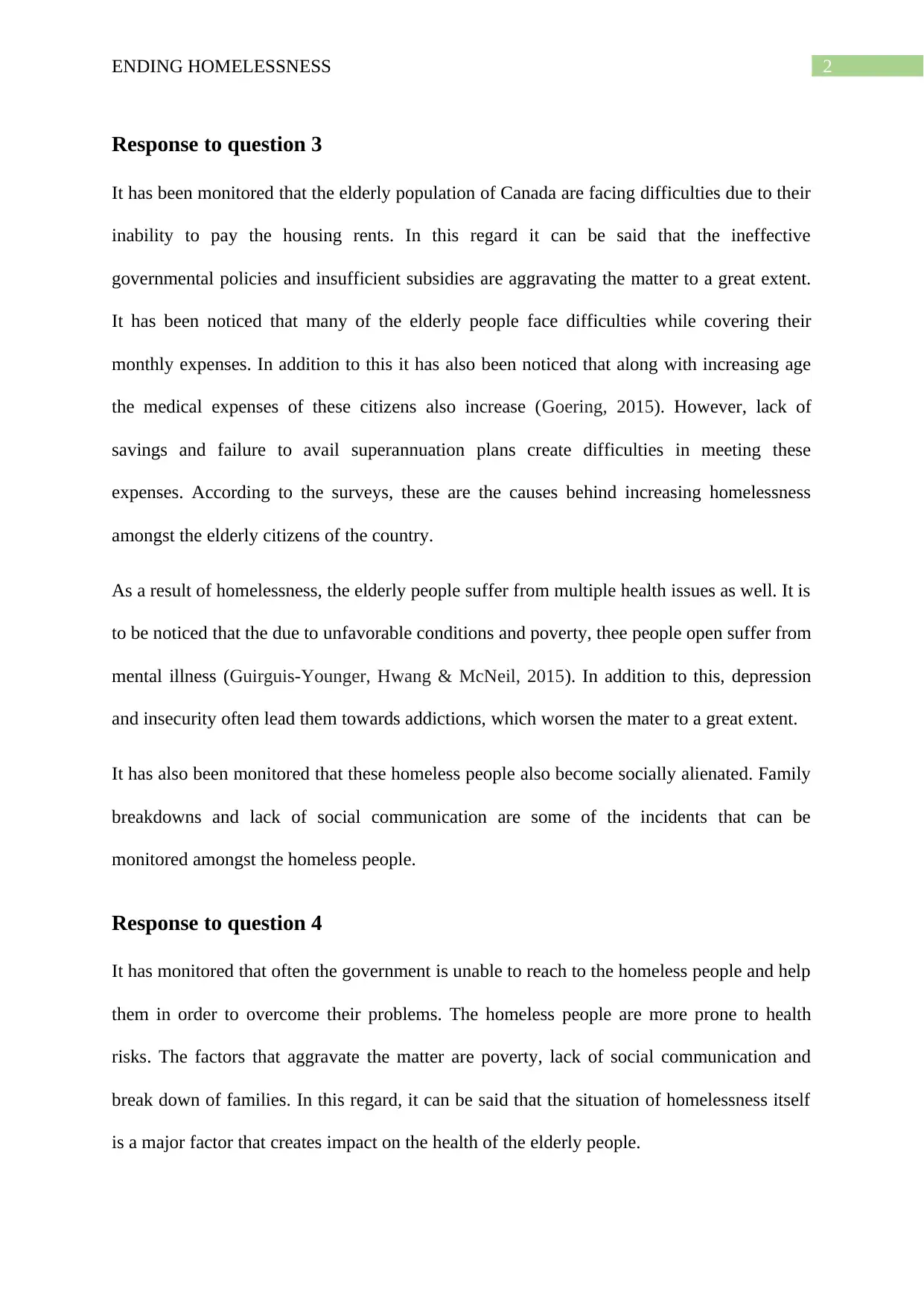
2ENDING HOMELESSNESS
Response to question 3
It has been monitored that the elderly population of Canada are facing difficulties due to their
inability to pay the housing rents. In this regard it can be said that the ineffective
governmental policies and insufficient subsidies are aggravating the matter to a great extent.
It has been noticed that many of the elderly people face difficulties while covering their
monthly expenses. In addition to this it has also been noticed that along with increasing age
the medical expenses of these citizens also increase (Goering, 2015). However, lack of
savings and failure to avail superannuation plans create difficulties in meeting these
expenses. According to the surveys, these are the causes behind increasing homelessness
amongst the elderly citizens of the country.
As a result of homelessness, the elderly people suffer from multiple health issues as well. It is
to be noticed that the due to unfavorable conditions and poverty, thee people open suffer from
mental illness (Guirguis-Younger, Hwang & McNeil, 2015). In addition to this, depression
and insecurity often lead them towards addictions, which worsen the mater to a great extent.
It has also been monitored that these homeless people also become socially alienated. Family
breakdowns and lack of social communication are some of the incidents that can be
monitored amongst the homeless people.
Response to question 4
It has monitored that often the government is unable to reach to the homeless people and help
them in order to overcome their problems. The homeless people are more prone to health
risks. The factors that aggravate the matter are poverty, lack of social communication and
break down of families. In this regard, it can be said that the situation of homelessness itself
is a major factor that creates impact on the health of the elderly people.
Response to question 3
It has been monitored that the elderly population of Canada are facing difficulties due to their
inability to pay the housing rents. In this regard it can be said that the ineffective
governmental policies and insufficient subsidies are aggravating the matter to a great extent.
It has been noticed that many of the elderly people face difficulties while covering their
monthly expenses. In addition to this it has also been noticed that along with increasing age
the medical expenses of these citizens also increase (Goering, 2015). However, lack of
savings and failure to avail superannuation plans create difficulties in meeting these
expenses. According to the surveys, these are the causes behind increasing homelessness
amongst the elderly citizens of the country.
As a result of homelessness, the elderly people suffer from multiple health issues as well. It is
to be noticed that the due to unfavorable conditions and poverty, thee people open suffer from
mental illness (Guirguis-Younger, Hwang & McNeil, 2015). In addition to this, depression
and insecurity often lead them towards addictions, which worsen the mater to a great extent.
It has also been monitored that these homeless people also become socially alienated. Family
breakdowns and lack of social communication are some of the incidents that can be
monitored amongst the homeless people.
Response to question 4
It has monitored that often the government is unable to reach to the homeless people and help
them in order to overcome their problems. The homeless people are more prone to health
risks. The factors that aggravate the matter are poverty, lack of social communication and
break down of families. In this regard, it can be said that the situation of homelessness itself
is a major factor that creates impact on the health of the elderly people.
⊘ This is a preview!⊘
Do you want full access?
Subscribe today to unlock all pages.

Trusted by 1+ million students worldwide
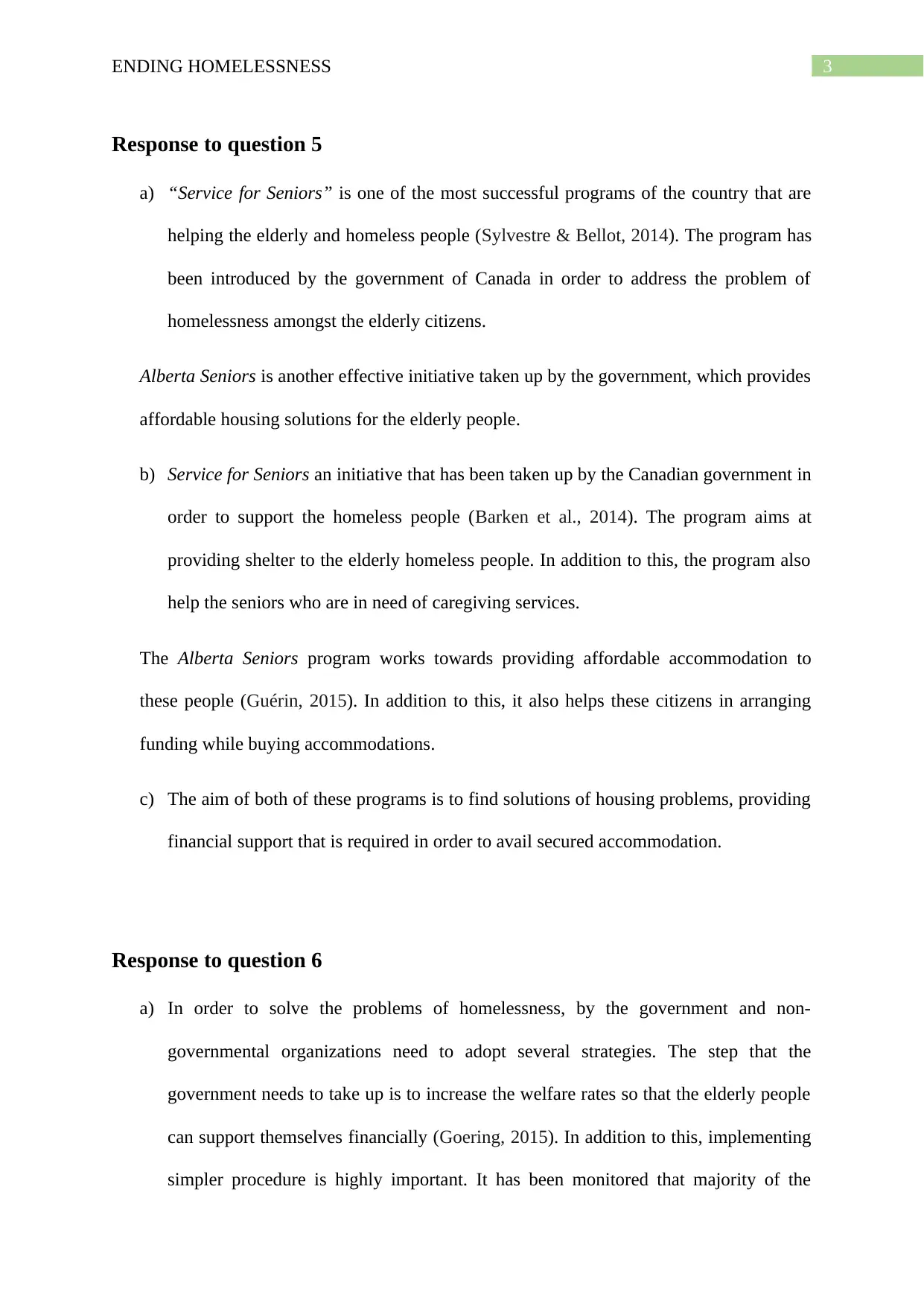
3ENDING HOMELESSNESS
Response to question 5
a) “Service for Seniors” is one of the most successful programs of the country that are
helping the elderly and homeless people (Sylvestre & Bellot, 2014). The program has
been introduced by the government of Canada in order to address the problem of
homelessness amongst the elderly citizens.
Alberta Seniors is another effective initiative taken up by the government, which provides
affordable housing solutions for the elderly people.
b) Service for Seniors an initiative that has been taken up by the Canadian government in
order to support the homeless people (Barken et al., 2014). The program aims at
providing shelter to the elderly homeless people. In addition to this, the program also
help the seniors who are in need of caregiving services.
The Alberta Seniors program works towards providing affordable accommodation to
these people (Guérin, 2015). In addition to this, it also helps these citizens in arranging
funding while buying accommodations.
c) The aim of both of these programs is to find solutions of housing problems, providing
financial support that is required in order to avail secured accommodation.
Response to question 6
a) In order to solve the problems of homelessness, by the government and non-
governmental organizations need to adopt several strategies. The step that the
government needs to take up is to increase the welfare rates so that the elderly people
can support themselves financially (Goering, 2015). In addition to this, implementing
simpler procedure is highly important. It has been monitored that majority of the
Response to question 5
a) “Service for Seniors” is one of the most successful programs of the country that are
helping the elderly and homeless people (Sylvestre & Bellot, 2014). The program has
been introduced by the government of Canada in order to address the problem of
homelessness amongst the elderly citizens.
Alberta Seniors is another effective initiative taken up by the government, which provides
affordable housing solutions for the elderly people.
b) Service for Seniors an initiative that has been taken up by the Canadian government in
order to support the homeless people (Barken et al., 2014). The program aims at
providing shelter to the elderly homeless people. In addition to this, the program also
help the seniors who are in need of caregiving services.
The Alberta Seniors program works towards providing affordable accommodation to
these people (Guérin, 2015). In addition to this, it also helps these citizens in arranging
funding while buying accommodations.
c) The aim of both of these programs is to find solutions of housing problems, providing
financial support that is required in order to avail secured accommodation.
Response to question 6
a) In order to solve the problems of homelessness, by the government and non-
governmental organizations need to adopt several strategies. The step that the
government needs to take up is to increase the welfare rates so that the elderly people
can support themselves financially (Goering, 2015). In addition to this, implementing
simpler procedure is highly important. It has been monitored that majority of the
Paraphrase This Document
Need a fresh take? Get an instant paraphrase of this document with our AI Paraphraser
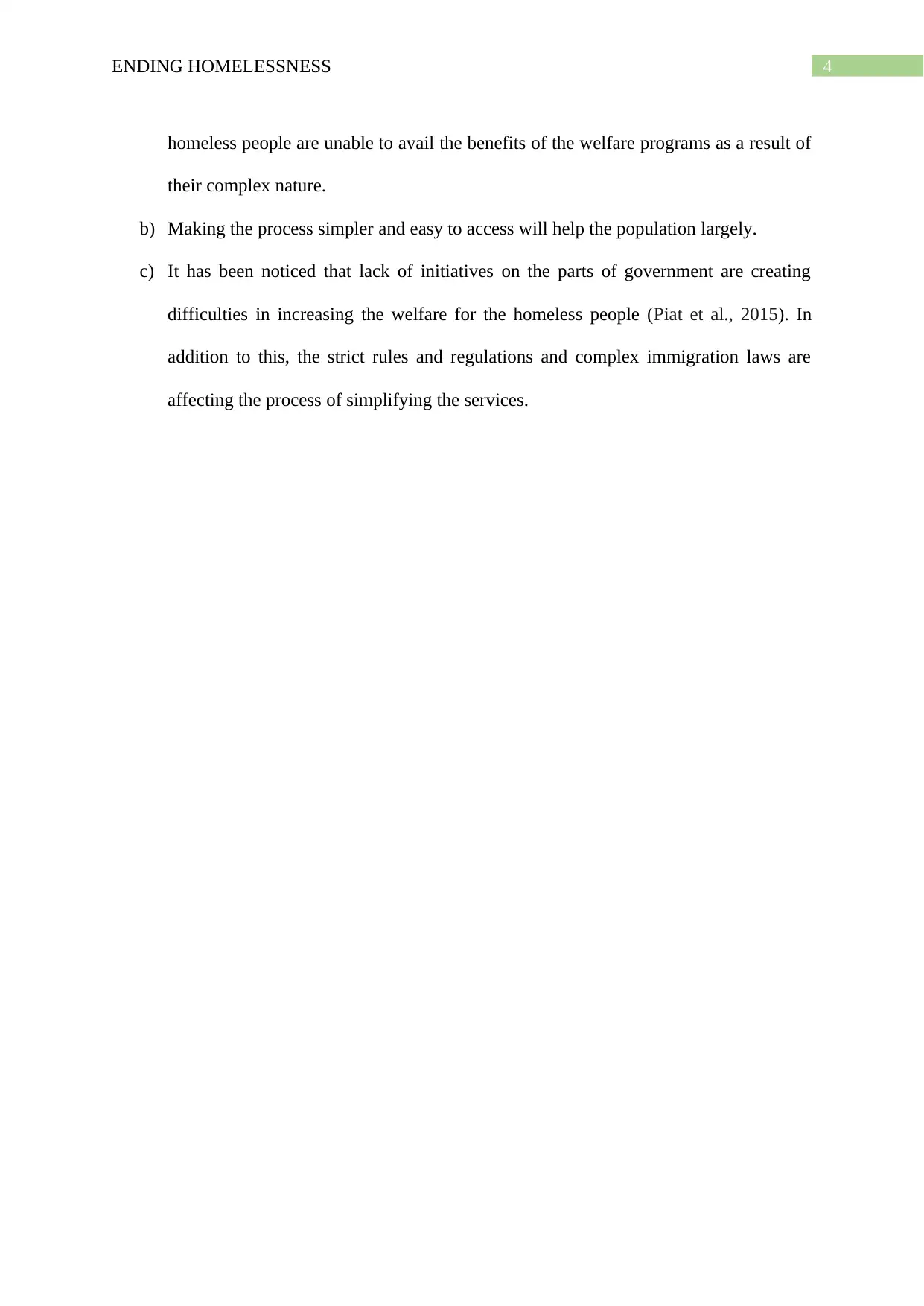
4ENDING HOMELESSNESS
homeless people are unable to avail the benefits of the welfare programs as a result of
their complex nature.
b) Making the process simpler and easy to access will help the population largely.
c) It has been noticed that lack of initiatives on the parts of government are creating
difficulties in increasing the welfare for the homeless people (Piat et al., 2015). In
addition to this, the strict rules and regulations and complex immigration laws are
affecting the process of simplifying the services.
homeless people are unable to avail the benefits of the welfare programs as a result of
their complex nature.
b) Making the process simpler and easy to access will help the population largely.
c) It has been noticed that lack of initiatives on the parts of government are creating
difficulties in increasing the welfare for the homeless people (Piat et al., 2015). In
addition to this, the strict rules and regulations and complex immigration laws are
affecting the process of simplifying the services.
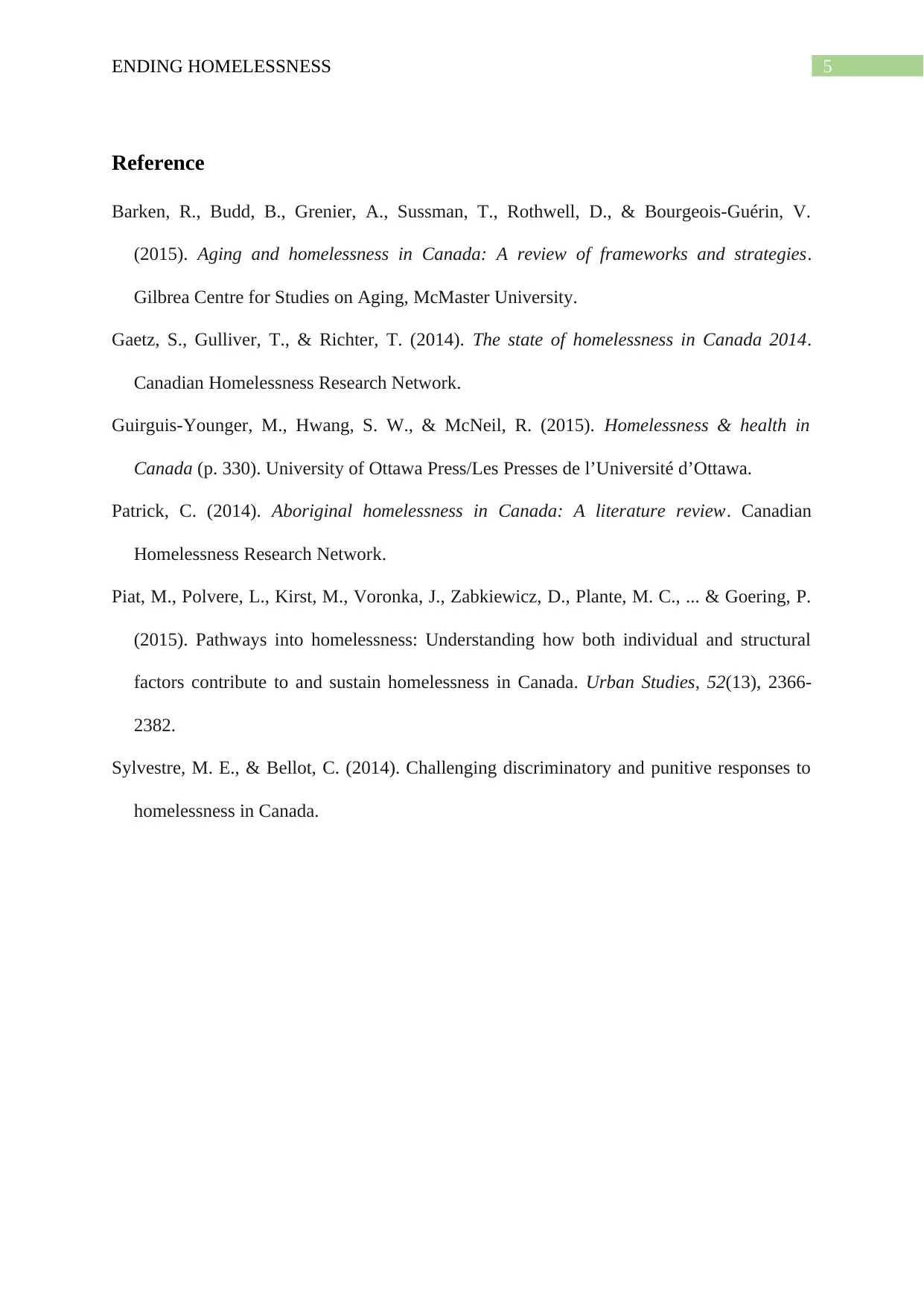
5ENDING HOMELESSNESS
Reference
Barken, R., Budd, B., Grenier, A., Sussman, T., Rothwell, D., & Bourgeois-Guérin, V.
(2015). Aging and homelessness in Canada: A review of frameworks and strategies.
Gilbrea Centre for Studies on Aging, McMaster University.
Gaetz, S., Gulliver, T., & Richter, T. (2014). The state of homelessness in Canada 2014.
Canadian Homelessness Research Network.
Guirguis-Younger, M., Hwang, S. W., & McNeil, R. (2015). Homelessness & health in
Canada (p. 330). University of Ottawa Press/Les Presses de l’Université d’Ottawa.
Patrick, C. (2014). Aboriginal homelessness in Canada: A literature review. Canadian
Homelessness Research Network.
Piat, M., Polvere, L., Kirst, M., Voronka, J., Zabkiewicz, D., Plante, M. C., ... & Goering, P.
(2015). Pathways into homelessness: Understanding how both individual and structural
factors contribute to and sustain homelessness in Canada. Urban Studies, 52(13), 2366-
2382.
Sylvestre, M. E., & Bellot, C. (2014). Challenging discriminatory and punitive responses to
homelessness in Canada.
Reference
Barken, R., Budd, B., Grenier, A., Sussman, T., Rothwell, D., & Bourgeois-Guérin, V.
(2015). Aging and homelessness in Canada: A review of frameworks and strategies.
Gilbrea Centre for Studies on Aging, McMaster University.
Gaetz, S., Gulliver, T., & Richter, T. (2014). The state of homelessness in Canada 2014.
Canadian Homelessness Research Network.
Guirguis-Younger, M., Hwang, S. W., & McNeil, R. (2015). Homelessness & health in
Canada (p. 330). University of Ottawa Press/Les Presses de l’Université d’Ottawa.
Patrick, C. (2014). Aboriginal homelessness in Canada: A literature review. Canadian
Homelessness Research Network.
Piat, M., Polvere, L., Kirst, M., Voronka, J., Zabkiewicz, D., Plante, M. C., ... & Goering, P.
(2015). Pathways into homelessness: Understanding how both individual and structural
factors contribute to and sustain homelessness in Canada. Urban Studies, 52(13), 2366-
2382.
Sylvestre, M. E., & Bellot, C. (2014). Challenging discriminatory and punitive responses to
homelessness in Canada.
⊘ This is a preview!⊘
Do you want full access?
Subscribe today to unlock all pages.

Trusted by 1+ million students worldwide
1 out of 6
Related Documents
Your All-in-One AI-Powered Toolkit for Academic Success.
+13062052269
info@desklib.com
Available 24*7 on WhatsApp / Email
![[object Object]](/_next/static/media/star-bottom.7253800d.svg)
Unlock your academic potential
Copyright © 2020–2025 A2Z Services. All Rights Reserved. Developed and managed by ZUCOL.





